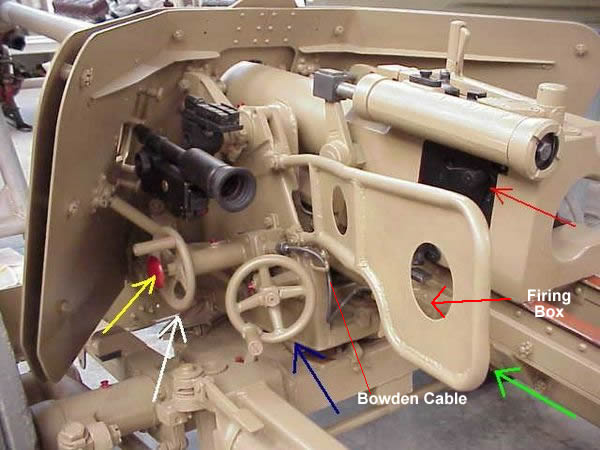 <–Well, that would certainly give you fire control from the Ele. wheel in that configuration. Meaning, it probably wasn’t the same on each varriant, and the varriant i’m interested in for my build is the earliest fielded example, which{if I borrow these photos from the aformentioned source} shows a simple lanyard hanging right where I was sayin :
<–Well, that would certainly give you fire control from the Ele. wheel in that configuration. Meaning, it probably wasn’t the same on each varriant, and the varriant i’m interested in for my build is the earliest fielded example, which{if I borrow these photos from the aformentioned source} shows a simple lanyard hanging right where I was sayin :
 Here a U.S. serviceman demo’s a captured gun in Tunisia(note cacti)
Here a U.S. serviceman demo’s a captured gun in Tunisia(note cacti)
Probably not going to fire it with all those rations sitting in the recoil tray, but you can see the little noose on that cord, and you can see it in that whole series of pictures in your A&A
 At least we agree which is the firing lever, right? It doesn’t look like a safe place to have your hand while firing the piece in anger, does it? Its my best guess that crews used a lanyard early on , and later the Pak40 came with the Bowden cable from the factory.
At least we agree which is the firing lever, right? It doesn’t look like a safe place to have your hand while firing the piece in anger, does it? Its my best guess that crews used a lanyard early on , and later the Pak40 came with the Bowden cable from the factory.
~And Manny…no reason that big guard can’t be both a recoil guard AND a trigger guard…right?
 I really believe that little tube is the gunsight storage for 3 reasons ~ 1. It’s exactly the correct size it would need to be & 2. The process of elimination leaves only that tube. 3. Look at it’s location~~right where it can be reached to deploy.
I really believe that little tube is the gunsight storage for 3 reasons ~ 1. It’s exactly the correct size it would need to be & 2. The process of elimination leaves only that tube. 3. Look at it’s location~~right where it can be reached to deploy.
 As far as these guns left to France here~ You got me, I didn’t notice the 1st readthrough that the tube(and cap DML omits) are on these guns. Of course, thats 1945, & they are the late model Pak40, and so I’ve never seen it on any shots of early ones still, so have to guess it was later added after it became appearent it was needed,and so does’nt belong on my piece, as far as I know. ~What gets me about this photo, is the caption says the guns are being refurbished for French use, but they look like they we’re destroyed as the breeches look burnt-out. Do you suppose that damage is in the process of being reversed? Does’nt seem like it would be possible in the field to me.
As far as these guns left to France here~ You got me, I didn’t notice the 1st readthrough that the tube(and cap DML omits) are on these guns. Of course, thats 1945, & they are the late model Pak40, and so I’ve never seen it on any shots of early ones still, so have to guess it was later added after it became appearent it was needed,and so does’nt belong on my piece, as far as I know. ~What gets me about this photo, is the caption says the guns are being refurbished for French use, but they look like they we’re destroyed as the breeches look burnt-out. Do you suppose that damage is in the process of being reversed? Does’nt seem like it would be possible in the field to me.
~Anyway, those are my best guesses, in most cases, based on the noted sources, and plenty of others( but is yet incomplete) . I hope you find my reasoning mostly sound, but I wouldn’t be opposed to additional Info sources if someone has them.
~Brumbles ~That site seems to have a few things to check out. The Pak40 page looked suspect right off the bat ,though, as they claim that gun is a model 1940( maybe if it’s a prototype–unlikely–and they would certainly mention that !)it has the late-model wheels(sure it could be cobled together(not a good reference if so) and most of all it’s got a Pak38 type muzzle break, so I’m not sure what it is. I will maybe take another look. See what you guys think of it.
Ok…Indy Out!


 So is The “right” side on a gun is the right side when looking down the muzzle? Or is this the left side were looking at? Any way you slice it it looks alot different than the “fire lever” inticated for the Marder in Nuts & Bolts
So is The “right” side on a gun is the right side when looking down the muzzle? Or is this the left side were looking at? Any way you slice it it looks alot different than the “fire lever” inticated for the Marder in Nuts & Bolts



![[Figure 64. 5-cm Pak 38.]](http://www.lonesentry.com/manuals/german-infantry-weapons/pics/64-5-cm-pak-38-50mm.jpg) |
|![[Figure 69. Breechblock of 5-cm Pak.]](http://www.lonesentry.com/manuals/german-infantry-weapons/pics/69-breechblock-5-cm-pak-50mm-antitank.jpg) Very good details of the use of the Pak 38 at this site
Very good details of the use of the Pak 38 at this site








